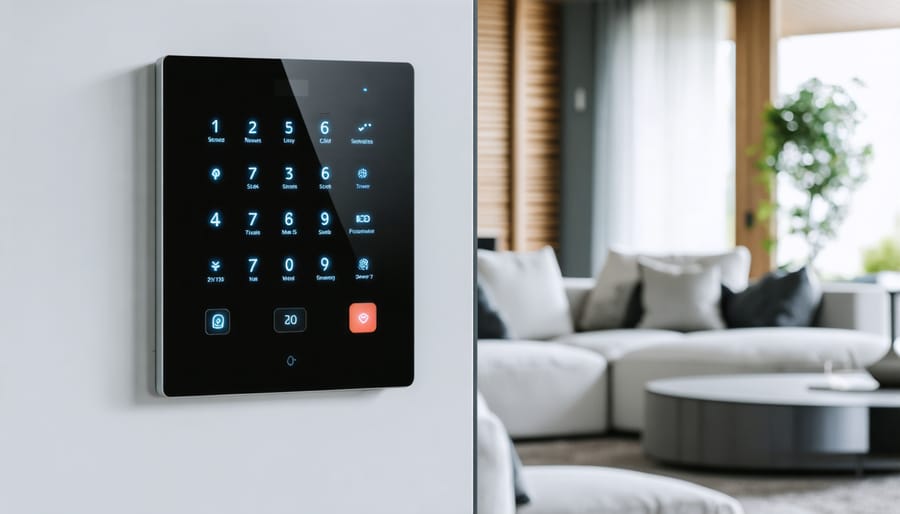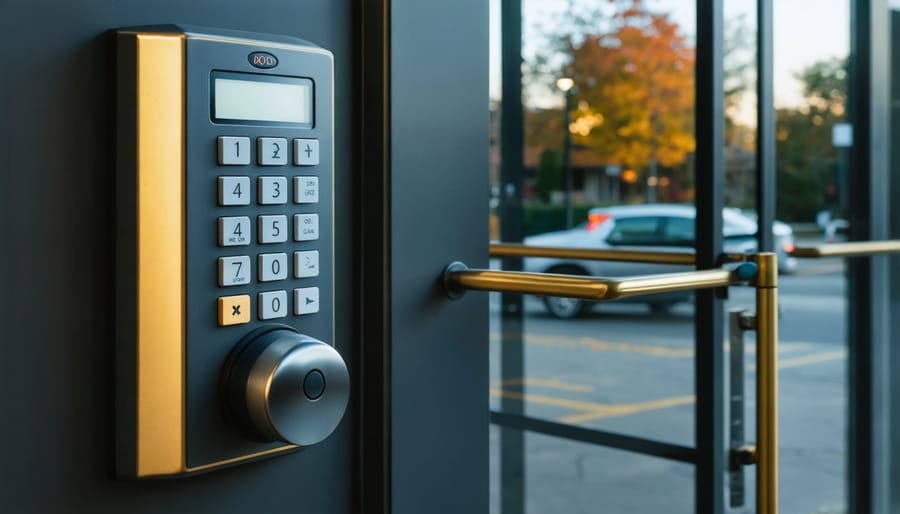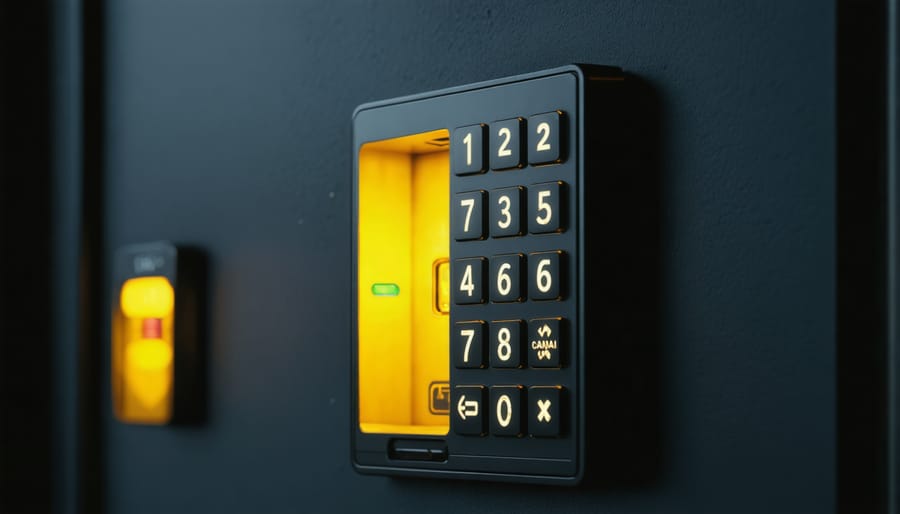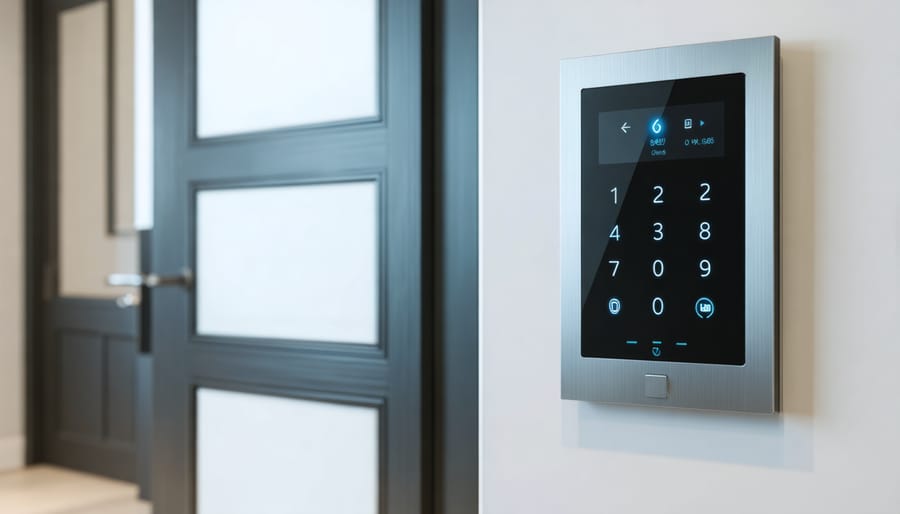Transform your home’s security with a modern keypad that serves as the command center for your smart home security systems. Today’s keypads combine military-grade encryption with intuitive touchscreen interfaces, letting you control access, monitor activity, and manage your entire security network from one sleek device.
Gone are the days of clunky number pads and forgotten codes. Modern security keypads integrate seamlessly with your smartphone, sending real-time alerts when doors are accessed and letting you remotely grant entry to trusted visitors. With customizable user codes for family members, housekeepers, or contractors, you maintain complete control over who enters your home and when.
Whether you’re upgrading an existing system or starting fresh, choosing the right keypad impacts both your home’s security and daily convenience. The latest models feature fingerprint recognition, voice control, and even facial scanning – transforming a basic security tool into an intelligent guardian that adapts to your lifestyle while providing peace of mind.
Modern Security Keypads: The Command Center of Your Smart Home
Touch Screens vs. Traditional Keypads
When it comes to home security keypads, you’re essentially choosing between two main contenders: sleek touch screens and reliable traditional keypads. Each brings something special to your home’s security setup.
Touch screens offer that modern, sophisticated look we’ve all come to love in our smartphones. They’re incredibly intuitive – just tap and go! Plus, many touch screen models come with bonus features like weather updates and customizable displays. The smooth surface is easier to clean (no more crud building up between buttons), and the interface can adapt to show different controls based on what you need.
Traditional keypads, on the other hand, have stood the test of time for good reason. There’s something reassuring about feeling those physical buttons click as you enter your code. They’re typically more affordable, and many users find they can input codes faster and more accurately without looking at the keypad – perfect for those late-night entries. They’re also generally more durable and less likely to be affected by extreme temperatures or moisture.
Your choice might ultimately come down to personal preference and lifestyle. If you love smart home integration and sleek aesthetics, a touch screen might be your perfect match. But if reliability and tactile feedback are your priorities, a traditional keypad could be the way to go.

Smart Features That Matter
Today’s security keypads pack impressive features that make protecting your home both smarter and more convenient. Voice control capabilities let you arm or disarm your system hands-free – perfect for those moments when you’re juggling groceries at the door. Real-time activity alerts keep you informed through smartphone notifications, whether you’re in the next room or across town.
Many modern keypads feature customizable user codes, allowing you to create temporary access for service providers or house guests without compromising your main security code. The integration of facial recognition and fingerprint scanning adds an extra layer of convenience and security, eliminating the need to remember complex combinations.
Perhaps most importantly, these keypads excel at smart home integration, seamlessly connecting with your lighting, thermostats, and cameras. This creates coordinated automations – like having your lights turn on and temperature adjust when you disarm the system. Geofencing capabilities can even remind you to arm the system when you leave, ensuring you never accidentally leave your home vulnerable.
Choosing the Perfect Location for Your Keypad
Choosing the perfect spot for your keypad is like finding the sweet spot between security and convenience. The ideal location should be easily accessible when you’re juggling grocery bags but not immediately visible to potential intruders peering through windows.
Start by considering your daily routines. The most common placement is near your primary entry point – typically your front door or garage entrance. You’ll want the keypad at a comfortable height, usually around 48-54 inches from the ground, making it easily accessible for all family members while remaining out of children’s casual reach.
Weather protection is crucial for outdoor installations. Choose a location under an overhang or covered porch to shield your keypad from direct rain and sunlight. For added security, avoid placing the keypad where it’s visible from the street – a slight recess or offset from the doorway provides both protection and privacy.
Consider lighting conditions throughout the day. While many modern keypads feature backlit buttons, you’ll still want adequate ambient lighting for comfortable access after dark. Installing a motion-activated light nearby can enhance both security and usability.
Don’t forget about your home’s electrical infrastructure. Most keypads require power and communication wiring, so choosing a location with easy access to these utilities will make installation smoother. If you’re planning a wireless keypad, ensure the chosen spot has reliable connectivity to your home’s security hub.
Finally, think about sight lines from inside your home. Being able to see who’s at the keypad from a window or security camera adds an extra layer of security while maintaining the convenience you need for daily use.


Essential Security Features to Look For
Tamper Protection and Backup Power
Ever wondered what happens to your security keypad during a power outage or if someone tries to tamper with it? Let’s tackle these crucial safety features that keep your home secure when you need it most.
Modern security keypads come equipped with sophisticated tamper-detection mechanisms that immediately trigger an alarm if someone attempts to pry open or damage the unit. Many models feature a tamper switch that activates when the keypad is removed from its mounting plate, ensuring you’re alerted to any unauthorized access attempts.
Backup power is equally essential for maintaining security during electrical failures. Most keypads include a built-in battery backup system that can keep your security system running for 8-24 hours, depending on the model. Some advanced units even feature dual backup systems: a primary battery backup and a secondary reserve power source for extended protection.
Here’s a smart tip: regularly test your backup power system by safely disconnecting the main power supply (just like you test your smoke detectors). Mark your calendar for quarterly checks to ensure everything’s working as it should. Also, consider installing a surge protector to shield your keypad from electrical spikes that could damage its sensitive electronics.
For extra peace of mind, many contemporary keypads now include cellular backup capabilities, ensuring your system stays connected to monitoring services even when both power and internet are down.
Mobile Integration and Remote Access
Gone are the days when your home security keypad was just a simple number pad on the wall. Today’s smart keypads bring your home security system right to your fingertips through your smartphone, making home protection more convenient and accessible than ever before.
Most modern security keypads come with dedicated mobile apps that transform your phone into a portable control center. Through these apps, you can arm or disarm your system, check entry logs, and receive instant notifications whenever someone enters your home. The real game-changer is the ability to perform remote security monitoring from anywhere in the world – perfect for when you’re traveling or want to check if the kids made it home from school.
These mobile-integrated keypads also allow you to create and manage unique access codes for family members, trusted neighbors, or service providers. You can set temporary codes that expire after a certain time or track which codes are used and when, giving you complete control over who enters your home.
The integration doesn’t stop there – many keypads now work seamlessly with other smart home devices. You can set up automated routines, like having your lights turn on when you disarm the system, or viewing your security cameras directly through the same app. It’s home security that fits your lifestyle, right in your pocket.
Installation and Setup Made Simple
Getting your new security keypad up and running doesn’t have to be a headache. Whether you’re a confident DIYer or prefer professional help, I’ll walk you through both paths to success. For those ready to tackle the project themselves, check out our comprehensive DIY security installation guide for detailed instructions.
For the DIY route, start by gathering your tools: a drill, screwdriver, level, pencil, and the mounting hardware included with your keypad. Choose a location near your main entry point, ideally 4-5 feet from the ground. Before drilling any holes, hold the mounting plate against the wall and use your level to ensure it’s perfectly straight – there’s nothing worse than a crooked keypad!
If your keypad is wireless, installation is typically straightforward: mount the backing plate, connect the battery, and snap the keypad into place. For hardwired models, you’ll need to run wires through your wall to connect to the control panel. This is where some homeowners prefer calling in the pros, and that’s perfectly fine!
Speaking of professional installation, most security companies offer this service for $100-200, depending on your location and system complexity. They’ll handle everything from wire routing to system programming, usually completing the job in 1-2 hours. The benefit? Peace of mind knowing your system is correctly installed and fully operational from day one.
Whichever route you choose, don’t skip the final steps: testing the keypad thoroughly and programming your access codes. Create a master code for yourself and separate codes for family members or trusted neighbors. Many modern keypads also let you set temporary codes for service providers or house guests – pretty handy for managing access without compromising security.
Remember to keep the instruction manual in a safe place and save your installer’s contact information if you opted for professional help. With proper installation, your keypad will serve as a reliable guardian of your home for years to come.
Choosing the right security keypad for your home is more than just a practical decision – it’s an investment in your family’s safety and peace of mind. Throughout this guide, we’ve explored the essential features, from biometric capabilities to weatherproof designs, that make modern keypads both secure and convenient. Remember that the perfect keypad should balance robust security features with user-friendly operation, seamlessly integrating with your existing smart home ecosystem.
Whether you opt for a sophisticated touchscreen model or a traditional numeric keypad, ensure it meets your specific needs and lifestyle. Consider factors like backup power options, remote access capabilities, and compatibility with other security devices. Don’t forget about future-proofing your investment by choosing a system that can grow with your changing security requirements.
Take time to research, compare options, and possibly consult with security professionals before making your final decision. After all, the right keypad isn’t just about keeping intruders out – it’s about creating a secure, comfortable environment where you can truly feel at home.

